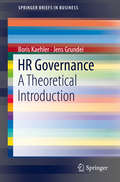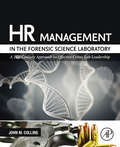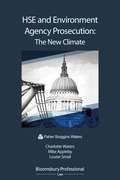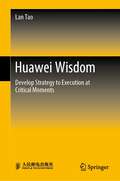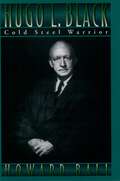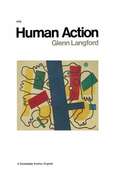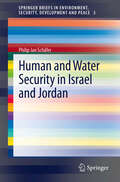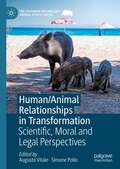- Table View
- List View
How We Hope: A Moral Psychology
by Adrienne MartinWhat exactly is hope and how does it influence our decisions? In How We Hope, Adrienne Martin presents a novel account of hope, the motivational resources it presupposes, and its function in our practical lives. She contends that hoping for an outcome means treating certain feelings, plans, and imaginings as justified, and that hope thereby involves sophisticated reflective and conceptual capacities. Martin develops this original perspective on hope--what she calls the "incorporation analysis"--in contrast to the two dominant philosophical conceptions of hope: the orthodox definition, where hoping for an outcome is simply desiring it while thinking it possible, and agent-centered views, where hoping for an outcome is setting oneself to pursue it. In exploring how hope influences our decisions, she establishes that it is not always a positive motivational force and can render us complacent. She also examines the relationship between hope and faith, both religious and secular, and identifies a previously unnoted form of hope: normative or interpersonal hope. When we place normative hope in people, we relate to them as responsible agents and aspire for them to overcome challenges arising from situation or character. Demonstrating that hope merits rigorous philosophical investigation, both in its own right and in virtue of what it reveals about the nature of human emotion and motivation, How We Hope offers an original, sustained look at a largely neglected topic in philosophy.
How Westminster Works . . . and Why It Doesn't
by Ian DuntBritish politics is broken.Anyone sitting down to watch the news will get the sense that something has gone terribly wrong. We have prime ministers who detonate the economy, secretaries of state who are intellectually incapable of doing the job and MPs who seem temperamentally unsuited to the role. Expertise is denigrated. Lies are rewarded. And deep-seated, long-lasting national problems go permanently unresolved. Most of us have a sense that the system doesn't work, but we struggle to articulate exactly why. Our political and financial system is cloaked in secrecy, archaic terminology, ancient custom and impenetrable technical jargon.Lifting the lid on British politics, How Westminster Works . . . and Why It Doesn't exposes every aspect of the system in a way that can be understood and challenged, from the heights of Downing Street to the depths of the nation's newsrooms, from the hallways of the civil service to the green benches of the Commons.Based on interviews with some of the leading voices in politics, from former occupants of No.10 to key figures in Whitehall, Westminster and Fleet Street, Ian Dunt provides exactly what people in power have always tried to avoid: a full description of the mechanisms of British government. And a vision of how we can fix it.
HR Governance: A Theoretical Introduction (SpringerBriefs in Business)
by Boris Kaehler Jens GrundeiHuman resource (HR) governance is a relatively new construct that has recently begun attracting more and more attention in both research and practice. As a part of corporate governance, it represents the internal and external normative framework of human resource management and its supervision in organizations. This book theoretically integrates HR governance with the related domains of corporate governance, general management, HR management, and leadership. By doing so, it provides scholars and practitioners in the field with a precisely delineated system of theoretical concepts for their work and helps to translate these concepts into concrete research questions and practical guidelines. By interpreting the new ISO 30408 norm on human governance and taking into account recent developments, the book helps to comply with and anticipate current and future HR regulations.
HR Management in the Forensic Science Laboratory: A 21st Century Approach to Effective Crime Lab Leadership
by John M. CollinsHR Management in the Forensic Science Laboratory: A 21st Century Approach to Effective Crime Lab Leadership introduces the profession of forensic science to human resource management, and vice versa. The book includes principles of HR management that apply most readily, and most critically, to the practice of forensic science, such as laboratory operations, staffing and assignments, laboratory relations and high impact leadership. A companion website hosts workshop PowerPoint slides, a forensic HR newsletter and other important HR strategies to assist the reader.Provides principles of HR management that readily apply to the practice of forensic scienceCovers and emphasizes the knowledge necessary to make HR management in the forensic science laboratory effective, such as technical standards and practices, laboratory structures and work units, and quality system management Includes an online website that hosts workshop PowerPoint slides, a forensic HR newsletter and other important HR strategies
HRM in Mission Driven Organizations: Managing People in the Not for Profit Sector
by Chris Brewster Jean-Luc CerdinThis edited collection examines human resource management in organizations other than those that are set up to make a profit. Covering human resource management in a number of different kinds of mission-driven organizations, the book explores organizations in sectors and industries such as the governmental and intergovernmental public sector, volunteer organizations and charities, religious organizations, cultural organizations, sports organizations and B-corporations. Recognizing the reality of management practice in the (many small) organizations covered by the book, the chapters deal with the way that people are actually managed whether or not there is an HRM department present. Students of business management and human resource management will find this book invaluable as a source of knowledge on not for profit organizations, as many of the chapters include detailed examples and case studies.
HSBA Handbook on Ship Finance
by Orestis Schinas Carsten Grau Max JohnsThis book is a major work that focuses exclusively on ship finance and includes contributions on the increasingly complex field of ship finance, which has over the last two decades become a key aspect in the world of shipping and ship owning. The book offers an enlightening mix of theoretical analysis and well-founded practical insights into the daily markets. Given that ship finance continues to develop dynamically around the world, the book covers subjects ranging from the German KG market to Islamic Finance, from loans to legal aspects and from asset pricing to risk management.
HSE and Environment Agency Prosecution: The New Climate
by Charlotte Waters Mike Appleby Louise SmailSentencing guidelines impose tough penalties for health and safety and environmental offences: how can you avoid them? The introduction of the sentencing guidelines in February 2016 has seen health and safety prosecutions treble, particularly in relation to corporate manslaughter, with tougher penalties imposed and fines exceeding £20 million being handed down. With fines having a detrimental effect on both turnover and reputation, how can companies protect themselves? HSE and Environment Agency Prosecution: The New Climate is an accessible reference work that provides guidance to ensure that companies have the correct, stringent risk management and procedures in place in order to protect themselves against exposure to such fines. Through the use of worked cases studies, checklists and charts the expert advice provided is put into context, whether you are a practitioner needing to advise your client, a company director, an in-house lawyer, or a health and safety professional. Split into four sections, this new title covers:Managing Risk; The Law; Enforcement and Sentencing; Inquests and Claims.
Huawei Wisdom: Develop Strategy to Execution at Critical Moments
by Lan TaoThis book reviews the three life-and-death crisis moments that Huawei experienced during its growth and the major transformation process triggered by these crises. It describes in detail how Huawei thinks about future strategies at these critical moments and how to implement these strategies during its daily work. This book involves the content of corporate globalization strategy decision making, overseas marketing, change management, etc.This book is suitable for middle and senior managers of the enterprises facing difficulties in product development, market development, and business model transformation, especially in the information and communication industry, manufacturing, etc. And it helps to inspire researchers and students, consultants, and trainers who major in corporate transformation, strategic management, and international marketing.
Huber and Headrick's Handwriting Identification: Facts and Fundamentals, Second Edition
by Heidi H. Harralson Larry S. Miller"Forensic document examination is the study of physical evidence and physical evidence cannot lie. Only its interpretation can err. Only the failure to find it, or to hear its true testimony can deprive it of its value."—Roy Huber This is a comprehensive update of Huber and Headrick's seminal work on handwriting examination. New coverage includes a review of forensic handwriting examination research, handwriting analysis training and proficiency, revised methods and procedures, an updated listing and clarification of terminology and electronic signatures, the analysis of digitized handwriting, and other related technological advances. The book includes updated photographs, several added illustrations, and advances in techniques based on the scientific research conducted in the area over the last 20 years. Features of the new edition include: The latest on electronic signatures, digital handwriting, automated handwriting verification, and the many advances in technology and research over the last two decades An overview of the fundamentals of handwriting examination with updated discussion of the intrinsic and extrinsic variables associated with handwriting identification A review of the criticism of handwriting expert opinions and methodology, addressing both the strengths and scientific limitations of the area Fully revised while remaining true to the spirit and approach of original authors Roy Huber and A. M. Headrick Addition of nearly 200 new references and new glossary terms representing advances in research and methods. With extensive photographs to help clearly illustrate concepts, Huber and Headrick’s Handwriting Identification: Facts and Fundamentals, Second Edition serves as an invaluable reference to law libraries, practicing document examiners, forensic and criminal justice students, and every lawyer handling cases in which the authenticity of handwriting and documents might be disputed.
Huber and Headrick's Handwriting Identification: Facts and Fundamentals, Second Edition
by Heidi H. Harralson Larry S. Miller"Forensic document examination is the study of physical evidence and physical evidence cannot lie. Only its interpretation can err. Only the failure to find it, or to hear its true testimony can deprive it of its value."—Roy Huber This is a comprehensive update of Huber and Headrick's seminal work on handwriting examination. New coverage includes a review of forensic handwriting examination research, handwriting analysis training and proficiency, revised methods and procedures, an updated listing and clarification of terminology and electronic signatures, the analysis of digitized handwriting, and other related technological advances. The book includes updated photographs, several added illustrations, and advances in techniques based on the scientific research conducted in the area over the last 20 years. Features of the new edition include: The latest on electronic signatures, digital handwriting, automated handwriting verification, and the many advances in technology and research over the last two decades An overview of the fundamentals of handwriting examination with updated discussion of the intrinsic and extrinsic variables associated with handwriting identification A review of the criticism of handwriting expert opinions and methodology, addressing both the strengths and scientific limitations of the area Fully revised while remaining true to the spirit and approach of original authors Roy Huber and A. M. Headrick Addition of nearly 200 new references and new glossary terms representing advances in research and methods. With extensive photographs to help clearly illustrate concepts, Huber and Headrick’s Handwriting Identification: Facts and Fundamentals, Second Edition serves as an invaluable reference to law libraries, practicing document examiners, forensic and criminal justice students, and every lawyer handling cases in which the authenticity of handwriting and documents might be disputed.
The Hubris Hazard, and How to Avoid It
by Eugene Sadler-SmithHubris is something we’ve all seen in action and experienced all too often. It’s a significant occupational hazard and a serious potential derailment factor for leaders, organisations, and civil society. Hubristic leaders - intoxicated as they are with power, praise, and success–behave in ways that, if left unchecked, invite unintended and unforeseen negative consequences which impact destructively on individuals, industries, economies, and nations.Despite numerous examples throughout history of hubris’ destructive consequences, it nonetheless appears to be an ever-present and growing danger. Many leaders seem to be blind to the hazards of hubris and oblivious to the lessons of history. Prevention is better than cure and understanding the nature of the hubris hazard and the associated risk factors will help leaders and managers improve their personal performance and avoid derailment and, even more importantly, protect the well-being of employees and the resilience of their organisations over the long term. This book explains the characteristics, causes, and consequences of hubris, and shows how to combat the significant hazard it poses to managers, leaders, organisations, and society. With contemporary examples, each chapter explores a particular ‘hubris risk factor’ and shows how the risk can be managed and mitigated and exposure to the hubris hazard minimised.The Hubris Hazard, and How to Avoid It offers practical guidance and action points for managers and leaders on how to recognise hubris in themselves and others and what to do to combat it when it arises. It will also be useful for business and executive coaches and leadership trainers and developers.
The Hubris Hazard, and How to Avoid It
by Eugene Sadler-SmithHubris is something we’ve all seen in action and experienced all too often. It’s a significant occupational hazard and a serious potential derailment factor for leaders, organisations, and civil society. Hubristic leaders - intoxicated as they are with power, praise, and success–behave in ways that, if left unchecked, invite unintended and unforeseen negative consequences which impact destructively on individuals, industries, economies, and nations.Despite numerous examples throughout history of hubris’ destructive consequences, it nonetheless appears to be an ever-present and growing danger. Many leaders seem to be blind to the hazards of hubris and oblivious to the lessons of history. Prevention is better than cure and understanding the nature of the hubris hazard and the associated risk factors will help leaders and managers improve their personal performance and avoid derailment and, even more importantly, protect the well-being of employees and the resilience of their organisations over the long term. This book explains the characteristics, causes, and consequences of hubris, and shows how to combat the significant hazard it poses to managers, leaders, organisations, and society. With contemporary examples, each chapter explores a particular ‘hubris risk factor’ and shows how the risk can be managed and mitigated and exposure to the hubris hazard minimised.The Hubris Hazard, and How to Avoid It offers practical guidance and action points for managers and leaders on how to recognise hubris in themselves and others and what to do to combat it when it arises. It will also be useful for business and executive coaches and leadership trainers and developers.
The Hughes Court: Justices, Rulings, and Legacy (ABC-CLIO Supreme Court Handbooks)
by Michael E. ParrishAn in-depth analysis of the workings and legacy of the Supreme Court led by Charles Evans Hughes.Charles Evans Hughes, a man who, it was said, "looks like God and talks like God," became chief justice in 1930, a year when more than 1,000 banks closed their doors. Today the Hughes Court is often remembered as a conservative bulwark against Franklin Roosevelt's New Deal. But that view, according to author Michael Parrish, is not accurate.In an era when Nazi Germany passed the Nuremberg Laws and extinguished freedom in much of Western Europe, the Hughes Court put the stamp of constitutional approval on New Deal entitlements, required state and local governments to bring their laws into conformity with the federal Bill of Rights, and took the first steps toward developing a more uniform code of criminal justice.
Hugo L. Black: Cold Steel Warrior
by Howard BallDuring his thirty-four year tenure as a Justice of the Supreme Court, Hugo L. Black demonstrated, in the words of one of his colleagues, "a true passion for the Constitution." At a moment's notice, in front of visiting students or a clutch of legal dignitaries, the Judge would whip his tattered copy of the Constitution from his coat pocket, flip through it to a particular passage and then, in a high voice, read the passage con vivace. And though Black began his political career in Alabama as the candidate of the Ku Klux Klan--with their help in 1926 he became a U.S. Senator--thirty years later, he would argue forcefully for an end to segregation in the South. In Hugo L. Black: Cold Steel Warrior, distinguished writer Howard Ball draws from Black's extensive files in the Library of Congress and on interviews with his colleagues on the Court, his law clerks, and his family to illuminate the enigmatic career of a man who became one of the twentieth century's most vigilant defenders of freedoms and liberty. Ball's examination of Black's life reveals a consummate politician who kept, in a safe beside his desk, the names, addresses, and backgrounds of all those who gave Black support from the time he ran for the county solicitor's job in Jefferson County, Alabama, through his two terms as a U.S. Senator. A fervent New Deal advocate, Black lent his support to F.D.R.'s court packing plan, and was one of the few who stood with the President until the measure's defeat in 1937. Less than one month later, F.D.R. rewarded Black by nominating him to the Supreme Court. Soon after Black's confirmation by the Senate, the story of his Klan membership spread across the nation, prompting Time magazine to write that "Hugo won't have to buy a robe, he can dye his white one black." One of Black's early opinions for the Court, however, changed most of the negative opinion about him. Writing for the majority in Chambers v. Florida, Black and his colleagues overturned charges against four African-American men unjustly accused of murder. In addition to Black's political and judicial career, Ball captures some of the great legal minds at work--Earl Warren, Thurgood Marshall, Felix Frankfurter, William O. Douglas, John M. Harlan II, and William J. Brennan--and their encounters with the tough Justice who was an immovable force when engaged in a constitutional battle. From Brown v. Board of Education and the first tests of the power of the federal courts to implement the Brown decision, to the height of McCarthyism and the national hysteria about Communism, to New York Times v. United States, the famous Pentagon Papers case in 1971 (Black's last opinion for the Court which defended a newspaper's First Amendment rights), Black emerges as a staunch defender of federalism and the primacy of the First Amendment, a strict, literal interpreter of the Constitution, and always proud to be a member of the Supreme Court. Throughout his life, Hugo Black's cockiness, sternness, and stubborn determination won him many critics. On every occasion, as Howard Ball shows, Black proved his critics wrong. He became a major presence in the Senate and one of the great Justices ever to sit on the Supreme Court.
Hugo Münsterberg's Psychology and Law: A Historical and Contemporary Assessment (American Psychology-Law Society Series)
by Brian H. Bornstein Jeffrey NeuschatzThough widely regarded as a founder of the modern field of psychology and law, German-American psychologist Hugo Münsterberg's now century-old ideas and research approaches continue to thrive. In fact, the discipline still grapples with many of the issues raised by Münsterberg in his seminal 1908 book, On the Witness Stand. Hugo Münsterberg's Psychology and Law makes Münsterberg's enduring insights available to a new generation of scholars, presenting the "state of the science" on the concepts that Münsterberg was one of the first to investigate. These include eyewitness memory, deception detection, false confessions, and the causes of criminal behavior. Opening with a brief biography of Münsterberg and a historical overview of the field, the book's organization follows that of On the Witness Stand, with each chapter providing a summary of Münsterberg's work followed by a contemporary perspective on the topic. Chapters challenge readers to consider what we have learned since Münsterberg's time and whether subsequent research has shown him to be right or wrong. The final chapter asks what Münsterberg may have missed, and what we may be missing today. This volume will be of interest to a broad range of scholars, practitioners, and professionals in the legal and mental health fields.
Hugo Münsterberg's Psychology and Law: A Historical and Contemporary Assessment (American Psychology-Law Society Series)
by Brian H. Bornstein Jeffrey NeuschatzThough widely regarded as a founder of the modern field of psychology and law, German-American psychologist Hugo Münsterberg's now century-old ideas and research approaches continue to thrive. In fact, the discipline still grapples with many of the issues raised by Münsterberg in his seminal 1908 book, On the Witness Stand. Hugo Münsterberg's Psychology and Law makes Münsterberg's enduring insights available to a new generation of scholars, presenting the "state of the science" on the concepts that Münsterberg was one of the first to investigate. These include eyewitness memory, deception detection, false confessions, and the causes of criminal behavior. Opening with a brief biography of Münsterberg and a historical overview of the field, the book's organization follows that of On the Witness Stand, with each chapter providing a summary of Münsterberg's work followed by a contemporary perspective on the topic. Chapters challenge readers to consider what we have learned since Münsterberg's time and whether subsequent research has shown him to be right or wrong. The final chapter asks what Münsterberg may have missed, and what we may be missing today. This volume will be of interest to a broad range of scholars, practitioners, and professionals in the legal and mental health fields.
Human Action, Economics, and Ethics (SpringerBriefs in Economics)
by Javier AranzadiIn the economical changing and political disturbing times we are living a question concerns us all: Is this the society I want to live in? What are the opportunities I have to pursue in my socio-cultural environment? Which echoes the ancient Greek ethical questions: What is the best city to live in? What do I want to do with my live?In this book the author goes back to the primary reality of our lives: human action. From the analysis of the anthropological elements of human action -culture, society, individual action- the book will help the reader to understand the construction of our economic reality and how to approach the perennial ethical question: How can I develop excellence in my life?
A Human Algorithm: How Artificial Intelligence is Redefining Who We Are
by Flynn ColemanThe age of intelligent machines is upon us, and we are at a reflection point. The proliferation of fast-moving technologies, including forms of artificial intelligence, will cause us to confront profound questions about ourselves. The era of human intellectual superiority is ending, and, as a species, we need to plan for this monumental shift. A Human Algorithm: How Artificial Intelligence Is Redefining Who We Are examines the immense impact intelligent technology will have on humanity. These machines, while challenging our personal beliefs and our socio-economic world order, also have the potential to transform our health and well-being, alleviate poverty and suffering, and reveal the mysteries of intelligence and consciousness. International human rights attorney Flynn Coleman deftly argues that it is critical we instil values, ethics, and morals into our robots, algorithms, and other forms of AI. Equally important, we need to develop and implement laws, policies, and oversight mechanisms to protect us from tech’s insidious threats. To realize AI’s transcendent potential, Coleman ad- vocates for inviting a diverse group of voices to participate in designing our intelligent machines and using our moral imagination to ensure that human rights, empathy, and equity are core principles of emerging technologies. Ultimately, A Human Algorithm is a clarion call for building a more humane future and moving conscientiously into a new frontier of our own design.
Human, All Too Human: A Book For Free Spirits (Arcturus Classics)
by Frederich NietzscheRanging from a few words to a few pages, the aphorisms in Human, All Too Human present Friedrich Nietzsche's thoughts on a variety of subjects, including the nature of reality (metaphysics); moral feelings, especially the concepts of good and evil; the argument that great art is the product of hard work as opposed to 'genius' and inspiration; free-thinking; the evolution of men, women and children; and the limitations that people put on their own thoughts and reasoning. The first of what became three volumes, Human, All Too Human not only represented a change in style for Nietzsche after the break-up of his friendship with the composer Richard Wagner and his rejection of Schopenhauer's influence, but also a move towards the views of the Enlightenment philosophers, particularly Voltaire and La Rochfoucauld. Human, All Too Human marks Nietzsche's decision to embrace new concepts and a fascinating turning point in the work of one of the 19th century's greatest philosophers.
Human and Nonhuman Bone Identification: A Concise Field Guide
by Diane L. FranceIn Human and Nonhuman Bone Identification: A Color Atlas,Diane L. France, one of the most respected forensic anthropologists in the world, offered a comprehensive handbook of photographs and other information essential for examining skeletal remains and determining species and body parts.Conveniently designed for field use, this compact version of
Human and Water Security in Israel and Jordan (SpringerBriefs in Environment, Security, Development and Peace #3)
by Philip Jan SchäferThe work aims at answering the question as to how far discourses on human security are present in Jordan and Israel, if they converge and if political solutions for the issue of water security could be derived. The analysis is based on the assumption that from human security perspective common solutions for urgent problems can be derived more easily than out of a perspective of national security. Yet it is acknowledged that according to a new security perspective different security threats are being identified by relevant actors. An empirical analysis of written statements and utterances of the respective security elites establishes the methodological tool for the identification of human security discourses in Israel and Jordan. Subsequently it is estimated how far water is presented as a matter of national security in Israel and Jordan using the theory of securitization.
Human/Animal Relationships in Transformation: Scientific, Moral and Legal Perspectives (The Palgrave Macmillan Animal Ethics Series)
by Augusto Vitale Simone PolloThe ethics of human/animal relationships is a growing field of academic research and a topic for public discussion and regulatory interventions from law-makers, governments and private institutions. Human/animal relationships are in transformation and understanding the nature of this process is crucial for all those who believe that the enlargement of moral and legal recognition to nonhuman animals is part of contemporary moral and political progress. Understanding the nature of this process means analysing and critically discussing the philosophical, scientific and legal concepts and arguments embedded in it. This book contributes to the discussion by bringing together the ideas and reflections of leading experts from different disciplinary backgrounds and with a range of scientific perspectives.This book both provides an up-to-date examination of the transformation of human/animal relationships and presents ideas to foster this process.
Human Aspects of Information Security and Assurance: 16th IFIP WG 11.12 International Symposium, HAISA 2022, Mytilene, Lesbos, Greece, July 6–8, 2022, Proceedings (IFIP Advances in Information and Communication Technology #658)
by Nathan Clarke Steven FurnellThis book constitutes the proceedings of the 16th IFIP WG 11.12 International Symposium on Human Aspects of Information Security and Assurance, HAISA 2022, held in Mytilene, Lesbos, Greece, in July 2022. The 25 papers presented in this volume were carefully reviewed and selected from 30 submissions. They are organized in the following topical sections: cyber security education and training; cyber security culture; privacy; and cyber security management.


